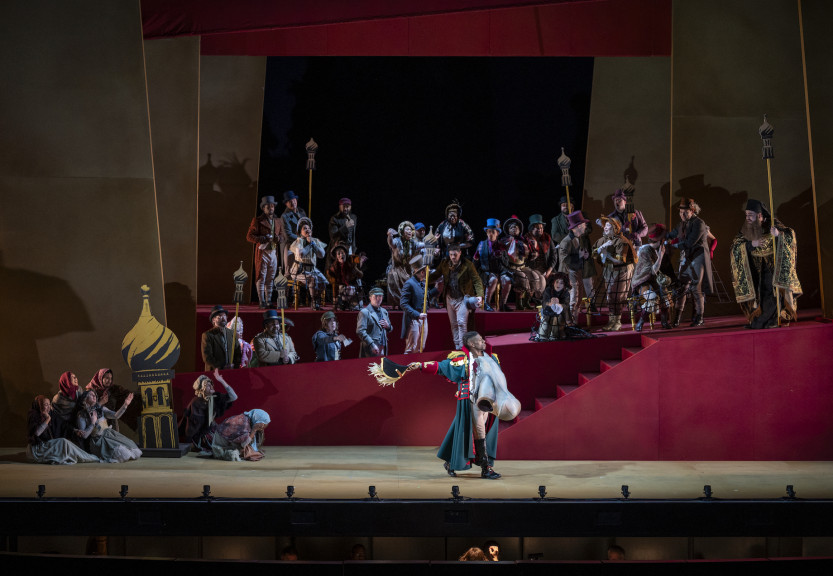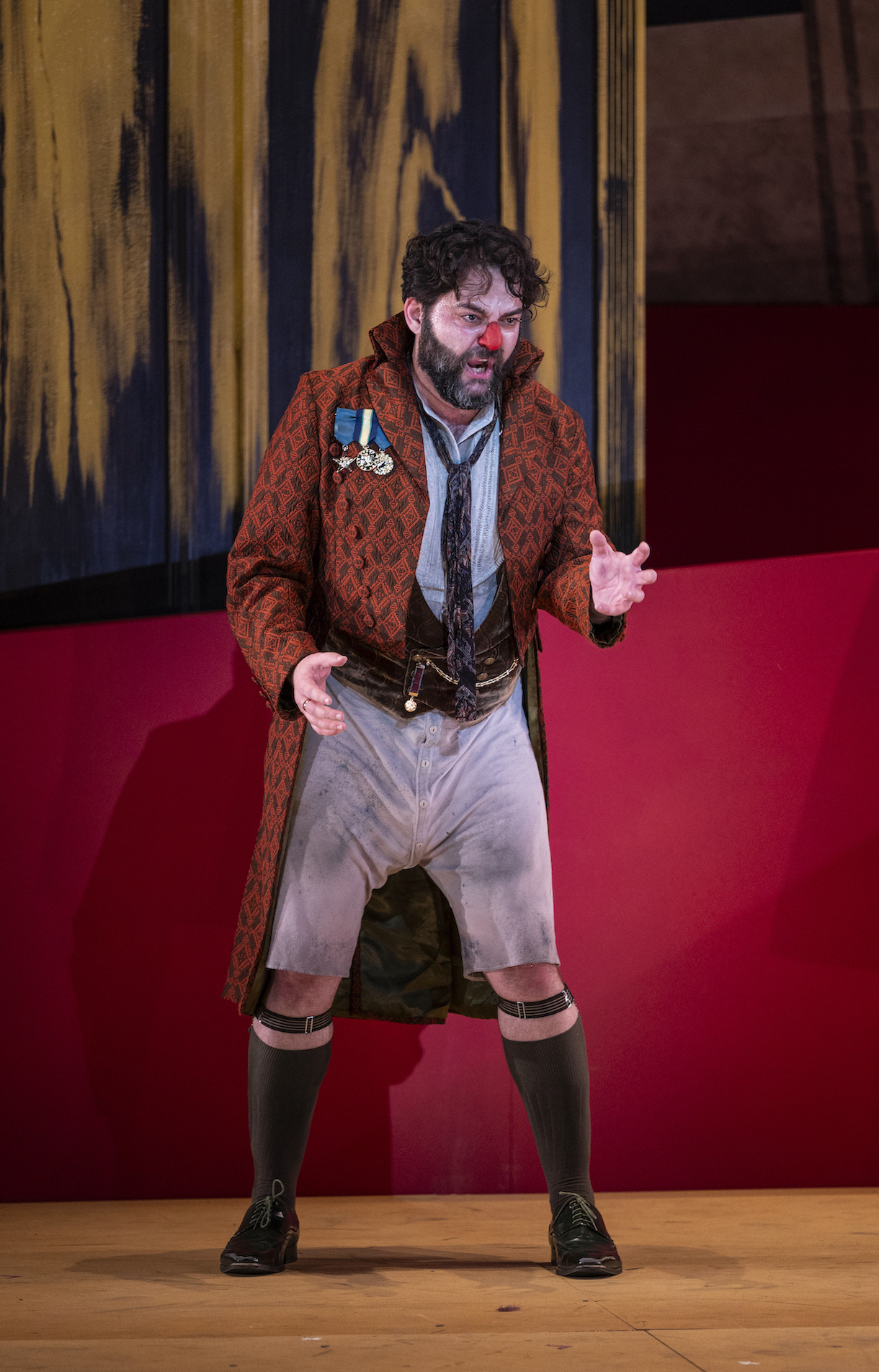Chicago Opera Theater: An Opera Company Worth Traveling For

Tenor Curtis Bannister as "The Nose" Michael Brosilow
Any Illinois opera lover worth their salt will know the Lyric Opera of Chicago, founded in 1954 and housed in the iconic Civic Opera House along the Chicago River. It is at Lyric that one can hear the warhorses of the operatic repertoire sung by some of the biggest international names in the business. You may have even traveled up to the city this fall for a doubleheader of Donizetti’s La Fille du Régiment starring Lawrence Brownlee and Lisette Oropesa and Janáček’s Jenůfa starring Lise Davidsen and Nina Stemme. But did you know there is another top-tier opera company in Chicago that has carved out its own niche?
Chicago Opera Theater (COT), celebrating its 50th anniversary this season, complements Lyric’s more traditional offerings by mounting new and lesser-known operas, often at more accessible price points. The company, which began as a grass-roots organization, has grown into a national leader in promoting opera as a vibrant, living art form, with high-quality productions featuring up-and-coming artists and local talent. Of the over 155 operas it has staged, 81 were new to Chicago, and 47 were by American composers. This commitment to new music is reflected in COT’s Vanguard Initiative, a two-year residency program for composers culminating in the premiere of a full-length opera commissioned by the company.
One recent Chicago premiere was Dmitri Shostakovich’s The Nose, which ran December 8 and 10. The nearly 100-year-old absurdist opera was on the bucket list of conductor Lidiya Yankovskaya, for whom these performances mark her last before stepping down as music director of COT. During her seven-year tenure, Yankovskaya was one of only two women to hold the title of music director of a multimillion-dollar opera company in the United States. As well as promoting new music, she has championed Slavic repertoire in particular, treating audiences to rarely heard gems by Tchaikovsky, Rachmaninov, and Polish composer Karol Szymanowski.
Shostakovich composed The Nose in 1927–1928—a tumultuous period in history that gave rise to the Soviet avant-garde. The 22-year-old composer embraced the intense artistic experimentation of the time with youthful vigor, producing a score that is as outlandish and chaotic as the opera’s plot. Within the soundscape of early 20th-century avant-garde orchestral music are strains of folk melodies, Russian sacred music, a waltz, and even jazz. The score is so chock-full that you simply can’t take it all in at once, and it is certainly not easy listening, especially as the singers are frequently brought to the extremes of their registers.
Based on a satirical short story by Nikolai Gogol, the opera centers around Kovalyov, a man obsessed with his appearance and rank in society. Kovalyov wakes up one morning to find that not only has his nose disappeared from his face, but it has also become a higher-ranking government official than him. A series of outlandish encounters ensues as Kovalyov attempts to find and reattach his nose. These episodes put him in contact with different subsets of society, from newspaper men and servants to upper-crust matrons, each ridiculed in equal measure. While Gogol satirizes 1830s tsarist Russia, Shostakovich’s operatic setting 90 years later levels an equally potent critique at Soviet society, highlighting the arbitrariness of social hierarchy and the superficiality of keeping up appearances. In fact, so biting was the satire and abrasive the music that the opera was banned in the Soviet Union for nearly 50 years after its premiere.
Bringing this opera to life was legendary director Francesca Zambello. Another female trailblazer in a male-dominated field, Zambello is the artistic director at Washington National Opera and directs operas all over the world, from the Metropolitan Opera to La Scala. Zambello and the rest of the creative team (Erik Teague, costumes; Marcus Doshi, set and lighting; Rebecca Scott, wigs and makeup) successfully married the two time periods of the piece with costumes that nodded to the 1830s and a stark red set piece that called to mind Soviet art of the 1920s.
Zambello matched the maximalism of the score with plentiful on-stage activity. In fact, so much was happening that it would require multiple viewings to catch everything while your eyes flit between the stage and the supertitles. The absurd humor of the libretto was brought out to great effect throughout, particularly with the character of the nose. Not-so-subtle innuendo was rife as the nose strutted and preened across the stage accoutered in a general’s costume and a giant plastic nose, attracting female attention wherever he went.

Baritone Aleksey Bogdanov as Kovalyov
PC: Michael Brosilow
COT often partners with other local performing arts organizations, and The Nose was no exception. Six dancers from the South Chicago Dance Theatre, led by choreographer Kia Smith, captured the restless energy of Shostakovich’s score and held the audience’s interest during extended orchestral interludes. This was especially effective during the extended percussion ensemble—the first example of its kind in classical music.
One of the major barriers to mounting The Nose is its large cast composed of over 11 principal singers and 22 ensemble singers, most of whom play multiple characters. Having so many named roles makes the opera expensive to produce, so this occasion was a rare treat, especially as opera companies have had to tighten their belts post-pandemic. COT often taps into the wealth of vocal talent of the Windy City, with many of the principal and ensemble singers calling Chicago home. The ensemble singers shone in the fiendishly intricate choral sections, bringing characterization and vocal power to even the smallest roles.
The major standout of the cast was the protagonist, Kovalyov, sung by Ukrainian–American baritone Aleksey Bogdanov. His fluency in Russian was apparent, as he was able to better make sense of the disjointed vocal lines than his castmates. Shostakovich’s fitful vocal writing sounded the most natural and musical in his voice, perhaps because he better understood the cadence and inflection of the language. His commanding vocal and dramatic performance earmarked him as a star who could easily sing this role on the world’s most prestigious stages.
Though COT’s offerings may not be to everyone’s tastes all the time, the company does mount a variety of repertoire throughout the season. Next up is Book of Mountains and Seas by Chinese composer/librettist Huang Ruo. Presented in collaboration with the Chicago International Puppet Theater Festival, the opera takes its inspiration from four Chinese fables that recount the Earth’s creation and destruction. The fantastical opera, which premiered in 2021, challenges us to reexamine our relationship with nature and be better stewards of our precious natural resources. Twelve singers from Ars Nova Copenhagen and two percussionists bring to life Ruo’s inventive score, which is inflected with Chinese folk music and features sung Chinese and an inveted language. A Beth Morrison Projects Production, the work will be conducted by Miles Lallemant and feature the staging of celebrated puppeteer Basil Twist.
COT is an opera company worth traveling for, be it to experience unique operatic offerings you can’t get anywhere else or to discover the next generation of singers. COT appears to be living up to its mission statement of “expanding the tradition of opera as a living art form.” So, if you find yourself in the city and are looking for something off-beat and thought-provoking, I highly recommend seeking out COT.
You can see the Midwest premiere of Ruo’s Book of Mountains and Seas on January 26 and 27, 2024, at 7:30 p.m. and January 28, 2024, at 3:00 p.m. at the Studebaker Theater in Chicago (Fine Arts Building, 410 S. Michigan Ave.).



